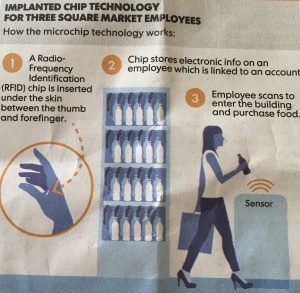Microchip Implants: Health and Privacy Concerns
According to the USA Today, a small Wisconsin company is going to implant very small microchips, Radio Frequency Identification Chip, in 50 employees’ hands on August 1st. Critics have expressed their concerns about health and privacy risks and creating a machine-like human being that damages human dignity.

This technology has been used in Sweden for the last three years on both human and pets. Privacy activists have expressed their opposition to the embedding a small device in human body that communicates with other electronics because they consider it as the invasion of privacy, health risk and real damage to the human dignity. A Nevada lawmaker is introducing a legislation for banning RFID chips in humans. Becky Haris, a Republican State Senator has expressed her concerns about the device’s ethical issues. She said that chipped individuals could be harassed by the right type of readers.
TURN OFF YOUR PUSH NOTIFICATIONS. ALL OF THEM
“PUSH NOTIFICATIONS ARE ruining my life. Yours too, I bet. Download more than a few apps and the notifications become a non-stop, cacophonous waterfall of nonsense. Over the last few years, there’s been an increasingly loud call for a re-evaluation of the relationship between humans and smartphones. For all the good that phones do, their grip on our eyes, ears, and thoughts creates real and serious problems. “I know when I take [technology] away from my kids what happens,” Tony Fadell, a former senior VP at Apple who helped invent both the iPod and the iPhone, said in a recent interview. “They literally feel like you’re tearing a piece of their person away from them. They get emotional about it, very emotional. They go through withdrawal for two to three days.” “I wake up in cold sweats every so often thinking, what did we bring to the world?” he says. “Did we really bring a nuclear bomb with information that can–like we see with fake news–blow up people’s brains and reprogram them? Or did we bring light to people who never had information, who can now be empowered?” Fadell was speaking as part of the Design Museum’s program around its current blockbuster exhibition, California, which examines the history and culture of digital technology in the Golden State, from early iPhone prototypes to the utopian festival and tech industry networking staple Burning Man to drawing of Apple Park. The conversation, called “Selling Freedom” brought together Fadell; Bethany Koby, the cofounder and CEO of toy company Technology Will Save Us; David Edgerton, a historian of science and technology at King’s College London; and Judy Wajcman, a sociologist at the London School of Economics who studies the social impact of technology. They were charged with examining the consequences of having so much revolutionary technology coming from a single place. (fastcodesign)
There’s a solution, though: Kill your notifications. Yes, really. Turn them all off. (You can leave on phone calls and text messages, if you must, but nothing else.) You’ll discover that you don’t miss the stream of cards filling your lockscreen, because they never existed for your benefit. They’re for brands and developers, methods by which thirsty growth hackers can grab your attention anytime they want. Allowing an app to send you push notifications is like allowing a store clerk to grab you by the ear and drag you into their store. You’re letting someone insert a commercial into your life anytime they want. Time to turn it off. Originally, push notifications were designed to keep you out of your phone rather than constantly drawing you in. When BlackBerry launched push email in 2003, users rejoiced: They didn’t need to constantly check their inbox for fear they’d miss important messages. When email comes, BlackBerry promised, your phone will tell you. Until then, don’t worry about it. It’s not like turning off notifications shuts you out from using the apps you like. It just puts you back in control; you’re on your phone when you want to be.” Wired

Foreigners Buying U.S. Houses
According to the Wall Street Journal, foreigners are buying U.S. homes at a record rate. As the result the house prices in coastal cities have gone up and there is supply shortage in some area. Last year, foreigners and recent immigrants purchased $153 billion of residential properties in the U.S. In 2015, foreigners had purchased $104 billion. It shows a dramatic increase over one year period.

Update your smartphone Now
“Apple has released a software update to iOS and macOS that you should download right away. The security update patches a dangerous vulnerability in WiFi chips that allows hackers to “execute arbitrary code” — industry-speak for taking over your device. Through the WiFi chip, a hacker may be able to assume control of your device’s processor, the central computer that runs everything else. To take advantage of the flaw, known as Broadpwn, all an attacker has to do is get within range of your WiFi device, according to Nitay Artenstein, the security researcher at Exodus Intelligence who discovered the problem and reported it. The flaw affects millions of Apple and Android devices; Google’s Android team released a patch for that platform earlier this month.” Washington Post

A new programming language called Kotlin
“YOU’LL FIND MILLIONS of apps that many of them written using the powerful, stable, workhorse programming language Java. In May Google gave Android developers another option when it announced it would start supporting a new programming language called Kotlin, which offers most of the same basic features as Java.Companies like Pinterest, Basecamp, and Square had already been using it. Although the first official release of Kotlin came only last year, the language has a history that stretches back to 2010. It was created by a Czech company called JetBrains, which makes software for programmers and project managers. But the team didn’t make Kotlin to sell. They made it to solve their own development problems.
Using Java means writing out lots of code that other languages tend to handle automatically. Something as simple as printing the phrase “Hello World” can take up three lines of code in Java, but usually only takes three words in modern languages; one of Kotlin’s biggest selling points is that it can be mixed and matched with Java, it has appeal far beyond companies with vast amounts of old Java code they still need to use.” Wired

Loss of a beautiful soul, a genius

“Stanford mathematics professor Maryam Mirzakhani, the first and to-date only female winner of the Fields Medal since its inception in 1936, died July 15 after a long battle with cancer. Mirzakhani was 40 years old. Professor Maryam Mirzakhani was the recipient of the 2014 Fields Medal, the top honor in mathematics. A self-professed “slow” mathematician, Mirzakhani’s colleagues describe her as ambitious, resolute and fearless in the face of problems others would not, or could not, tackle. She denied herself the easy path, choosing instead to tackle thornier issues. Her preferred method of working on a problem was to doodle on large sheets of white paper, scribbling formulas on the periphery of her drawings. Her young daughter described her mother at work as “painting.” “You have to spend some energy and effort to see the beauty of math,” she told one reporter. Mirzakhani was born in Tehran, Iran. She dreamed of becoming a writer, but mathematics eventually swept her away. Mirzakhani first gained international recognition during the 1994 and 1995 competitions. In 1994, she earned a gold medal. In 1995, she notched a perfect score and two gold medals. After graduating college at Sharif University in Tehran. she headed to graduate school at Harvard University, where she was guided by Curtis McMullen, a fellow Fields Medal winner. At Harvard, Mirzakhani was distinguished by her determination and relentless questioning, despite the language barrier. She peppered her professors with questions in English. She jotted her notes in Parsi language. In recent years, she collaborated with Alex Eskin at the University of Chicago to answer a mathematical challenge that physicists have struggled with for a century: the trajectory of a billiards ball around a polygonal table. That investigation into this seemingly simple action led to a 200-page paper which, when it was published in 2013, was hailed as “the beginning of a new era” in mathematics and “You’re torturing yourself along the way,” she would offer, “but life isn’t supposed to be easy.” Stanford University website
Big Companies Pay Scholars To Influence Policies
“Google operates a little known program to harness the brain power of university researchers to help away opinions and public policies. Over the past decade, Google has helped financing hundreds of research papers to defend against regulatory challenges of its market dominance. Google has paid professors whose papers, for instance, declared that the collection of consumer data was a fair exchange for its free services. Money spent on the research measures in the low millions of dollars, according to the former employee and former lobbyist. “Such corporate funding runs the risk of creating the impression that academics are lobbyists rather than scholars, said Robin Feldman in a Harvard University law journal article. The Tech industry now includes the world’s top five companies by market value: Apple Inc., Google parent Alphabet Inc., Microsoft Corp., Amazon Inc. and Facebook Inc. In 2010, Google hired Davenport Desai, a professor of Law and Ethics! and paid him more than $2 million in order to find academics to write research papers helpful to Google. Tech companies collect personal information including data some users would rather not share and sell it to the advertisers. Some privacy advocates say the policies are long and confusing and few people read them and the activists seek rules to limit the use of personal data.” The Wall Street Journal

Trader Gaining over $200 Million in One Month
“An unknown cryptocurrency trader turned $55 million of paper wealth into $283 million in just over a month.The only clue about this person or persons, beyond a virtual wallet with the identification code 0x00A651D43B6e209F5Ada45A35F92EFC0De3A518, surfaced on a June 11 Instagram posting, in Indonesian, in which he or she (or they) (or somebody posing as them) boasted about the 413 percent profit accumulated earlier this year from ether, the digital money of the Ethereum blockchain.
“I get many private messages asking how much ether I have,” the post read, alongside photos that purported to be the hardware powering a mining operation but looked lifted from another website. “One of the cool things about Ethereum is that all wallets around the world are transparent and open for everyone to see. And this is my wallet’s savings.”Secrecy persists from the days, earlier this decade, when Ross Ulbricht, going by the nom de guerre Dread Pirate Roberts, used bitcoin to launder money and traffic in narcotics, activities for which he started serving a life term at the Metropolitan Correctional Center in New York. That’s not to say that 0x00A651D43B6e209F5Ada45A35F92EFC0De3A518or any other entities are doing anything illegal. But opacity may be worsening jagged price movements. The value of ether, for example, rose from about $8 a unit at the start of the year to crest at $400 in June before settling around $250 today. A lack of transparency could also be stifling the mainstreaming of online money, according to draft legislation issued by the European Parliament in March.”
Bloomberg

Futuristic Lab & Heating and Cooling Systems
“A new startup called Dandelion, born from the secretive and futuristic lab “X” of Google’s parent company Alphabet, says it will offer a geothermal heating and cooling systems to homeowners. Existing systems are typically expensive with big upfront installation fees, discouraging homeowners from adopting the technology. Home geothermal systems tap into the ground’s energy. Because geothermal energy is generated and stored in the earth, these systems use plastic pipes in the ground and a pump inside the home. In the winter, water located inside the pipes absorbs heat from the earth. The pump then turns it into warm air. In the summer, the pump pulls warm air out of the home and the pipes disperse the heat back into the ground. Installing the pipes — called “ground loops” — under someone’s lawn is a traditionally invasive, messy process. It involves using wide drills that dig wells more than 1,000 feet underground. Dandelion’s drill is fast and lean, allowing for only one or two deep holes a few inches wide. The system will cost between $20,000 and $25,000, compared to conventional systems priced as high as $60,000.” CNN

Fake News for Financial Gains
“Many court documents allege that Bjorlin was the mastermind behind secretly paying writers — some of whom used pseudonyms such as the Swiss Trader and falsely claimed to have MBAs — to produce hundreds of positive articles, tweets and Facebook posts that attempted to pump up the stock prices of specific companies. In one case, according to a Securities and Exchange Commission complaint, Bjorlin’s firm helped drive up by 925 percent the stock price of Galena Biopharma, a small pharmaceutical company, after placing dozens of articles about the company in reputable online outlets. Once, such hype might have targeted the uninitiated, but these days, an increasing number of stock trades are driven by computers making split-second decisions about when to buy or sell — often by using sophisticated algorithms to monitor price changes and even the flow of news on mainstream outlets and social media. Some worry that strategically placed commentary can move markets before experienced humans have time to sniff out a con. At a time when investment firms are increasingly experimenting with artificial intelligence and technology that can make trading decisions in a fraction of a second, identifying disreputable sources has become a bigger challenge. In a recent research report, JPMorgan Chase estimated that just 10 percent of daily trading is done by human stock pickers. In an email exchange with The Washington Post, Bjorlin said: “No matter what story you publish, it won’t be the truth. There is an iceberg beneath the surface, that no one is paying attention to. I was targeted.” Some critics believe that the problem is far more complicated and Bjorlin has been considered an easy target to point to.”
Washington Post

Synthesizing An Entire Human Genome
“New York’s waterfront is where Modern Meadow has its labs and offices. There, the 60-person startup takes tiny microbes and edits their DNA- the genetic code that programs their behavior—so they will yield collagen as a metabolic product, just as the yeast that brew beer create alcohol from grain sugar. The result is a microbiological factory, as the tweaked cells multiply in vats and the harvested collagen is processed.

The dawn of the Synthetic Age is not just the province of scientist-dreamers and Brooklyn startups. A 2016 Transparency Market Research report predicted that the synthetic biology market would grow from $1.8 billion in 2012 to $13.4 billion by 2019. Last year, synthetic biology companies took in $1 billion from investors—including tech titans like Eric Schmidt, Peter Thiel and Marc Andreessen—double the total from 2014. Even the giants of the fossil-fuel world have gotten in on the game—Exxon Mobil has a $600 million deal with Synthetic Genomics, a partnership that bore fruit in June when the company announced a major breakthrough in engineering strains of algae to produce oil for use in sustainable biofuels.
If the idea of synthesizing an entire human genome alarms you, you’re not alone—even some synthetic biologists, like Stanford’s Endy, are wary of the notion. The researchers behind GP-write have made it clear that they have no intention of creating artificial people with their synthesized DNA; rather, their work will be confined to synthesizing human cells, in an effort to better understand how the human genome works—and, potentially, how to make it work better. But any attempt to engineer the genetic code of living beings raises ethical concerns—first over safety, and even more so, over success. What happens if an engineered plant or animal escapes into the wild, where its impact on the environment would be hard to predict? Engineering human cells to eliminate deadly genetic disorders might seem straightforward, but where would we draw the line between treatment and enhancement? “We’re developing powerful tools that are changing what it is to be human,” says Jim Thomas, a researcher with the technology watchdog the ETC Group. “The worry is that you could have market-driven eugenics.”

Of course, those ethical questions assume that synthetic biologists will be able to replicate a human genome—and that’s far from certain. Scientists have yet to fully synthesize the genomes of much simpler single-celled organisms like yeast, so it could take far longer than a decade to learn how to write the 20,000 or so genes in a human genome. And like all technologies moving from the lab to the real world, synthetic biology will need to compete with conventional products in the market and at scale. Over the past several decades, startups that employed the tools of synthetic biology to produce advanced biofuels burned through hundreds of millions of dollars in a mostly futile effort to beat cheap gasoline. But whether it happens in the near term or the long term, the science behind synthetic biology—the ability to read and write the code of life—is already with us. And it’s poised to re-engineer the world as we know it.
The language of DNA may have been written billions of years ago, but we learned to read it only in recent years. Sequencing DNA—determining the precise order of the C, G, A and T—was first done only in the 1970s, and for years it was laborious and expensive. It took more than 10 years and about $2.7 billion for the scientists behind the Human Genome Project to complete their mission: the first full sequence draft of the genes that encode a human being. But thanks in part to technology advances driven by that public-private effort, the price of sequencing DNA has plummeted—it now costs around $1,000 to sequence a person’s full genome—even as the speed has multiplied, to little more than a day.
As it turned out, even the world’s simplest bacterial genome was more complicated than scientists might have suspected. Of the 473 genes in Venter’s pared-down, synthetic cell, the functions of 149 were completely unknown. That’s almost a third, which underscores how far scientists have to go before they can truly claim to understand the genetic code that we can now sequence so easily—let alone effectively synthesize the genomes of much bigger and more complex organisms. It brings to mind another Feynman quote—“the difference between knowing the name of something and knowing something.”

Synthetic biologists won’t be satisfied with simply copying existing forms of life; they want to engineer something new, and even bring long-dead organisms back to life. Ginkgo is working on extracting DNA molecules from plant specimens preserved in herbariums, to synthesize the fragrances of flowers that have gone extinct, like an olive bush from the South Atlantic island of St. Helena that disappeared from the wild in 1994. The Bay Area startup Bolt Threads has engineered yeast microbes that can secrete spider silk, a material that is stronger than steel and yet extremely lightweight. Bolt has already used the spider silk thread to make ties, but the superstrong material could have a future in pharmaceutical products and the military.
And so we will, as the products of synthetic biology steadily migrate from the laboratory into the world around us. If the skepticism surrounding genetically modified foods is any lesson, that migration won’t happen without a fight. According to a 2015 Pew Research Center poll, only 37 percent of the general public believes GM foods are safe to eat, compared with 88 percent of scientists. But while the burden of proof will be on the proponents of synthetic biology, it’s worth keeping in mind that while the solutions are debatable, the existential environmental challenges our planet faces—around food, fuel and the climate—are not. Right now, some 40 percent of the world’s land is taken up for food production, which leaves less and less space for any other species—and despite that, one in nine people still lacks enough to eat. Yet somehow we’ll need to feed an additional 2 billion people by midcentury. The world may need to reach zero total carbon emissions as early as 2050 to escape dangerous climate change—yet we’ve barely begun to stop the increase in global emissions, let alone ratchet them back, and 1.2 billion people still lack any access to electricity, renewable or not. The status quo will not get us to where we need to be.
Harvard’s George Church is one of the giants of synthetic biology and a force behind the GP-write group. He’s also the kind of bold scientist who makes bioethicists and environmentalists worry, by planning to resurrect the extinct wooly mammoth through gene editing and openly musing on the possibility of genetically enhancing human beings by making them invulnerable to disease. When Stephen Colbert had Church on The Colbert Report in 2012, the TV host asked the scientist: “How do you think your work will eventually destroy all mankind?” He was joking—mostly.”
Source: Newsweek
When the Big Advertisers Seeking more Transparency
“Both P&G and Unilever appear to have pulled back on their digital spending, materially reducing their budgets as well as the number of sites they buy on. According to estimates from MediaRadar, a New York-based advertising intelligence company, P&G’s ad spend dropped 41% year-over-year, while Unilever’s dropped 59%. While P&G ran ads on 1,459 sites between January and May 2016, that number dropped to 978 sites in the same period in 2017–a decline of 33% in sites featuring P&G ads year-over-year. Unilever, on the other hand, advertised on 606 sites between January and May 2016, which fell to 540 sites in 2017, representing an 11% drop in websites featuring Unilever ads. P&G and Unilever do not break down their digital ad spend publicly.” Business Insider

Increasing Worries about Chinese acquisitions of U.S. companies
Chinese companies have increasingly been purchasing American companies and assets. Chinese companies have been buying up overseas companies including American ones, at a record rate, and there has been increasing pressures on lawmakers to do something about it. Global bankers have been helping Chinese companies acquire overseas and now they have to respond to the lawmakers.

Extra Virgin Olive Oil Preserves Memory and Protects Brain Against Alzheimer’s
“The Mediterranean diet, rich in plant-based foods, is associated with a variety of health benefits, including a lower incidence of dementia. Now, researchers at the Lewis Katz School of Medicine at Temple University (LKSOM) have identified a specific ingredient that protects against cognitive decline: extra-virgin olive oil, a major component of the Mediterranean diet. In a study published online June 21 in the Annals of Clinical and Translational Neurology, the researchers show that the consumption of extra-virgin olive oil protects memory and learning ability and reduces the formation of amyloid-beta plaques and neurofibrillary tangles in the brain — classic markers of Alzheimer’s disease.” Neuroscience Journal

Time Warner Signs $100 Million Deal With Snap for Shows and Ads
“Two-year Time Warner-Snap pact includes commitment for up to 10 original shows a year
In a wide-ranging deal with Snap Inc., Time Warner Inc.’s Turner cable channels and the Warner Bros. studio will create up to 10 original shows a year for the ephemeral messaging app in genres including scripted drama and comedy.” WSJ

Amazon Said to Plan Cuts to Shed Whole Foods’ Pricey Image
“When Amazon.com Inc. completes its acquisition of Whole Foods Market Inc. Chief Executive Officer Jeff Bezos will try to keep the grocer’s reputation for premium fresh foods while cutting prices to shed its “Whole Paycheck” image.
Amazon expects to reduce headcount and change inventory to lower prices and make Whole Foods competitive with Wal-Mart Stores Inc. and other big-box retailers, according to a person with knowledge of the company’s grocery plans. That included potentially using technology to eliminate cashiers. An Amazon spokesman denied any job cuts were planned. Amazon, known for its competitive prices, is trying to attract more low- and middle-income shoppers with its grocery push. The Seattle-based company already offers discounted Amazon Prime memberships for people receiving government assistance and is part of a pilot program to deliver groceries to food-stamp recipients. Whole Foods has already been reducing prices to try to turn around its worst sales slump since going public in 1992. It has four “365 by Whole Foods Market” stores that are cheaper to build and operate than a traditional location and offer lower-priced items aimed at younger shoppers.” Bloomberg

Employees Financial Wellbeing
According to the Wall Street Journal, sixty percent of companies that participated in the survey believed the importance of employees financial wellbeing had increased over the last two years. And most of them had some type of planning for it.

Big Data, artificial intelligence and algorithms designed and manipulated by strategists
“Big Data, artificial intelligence and algorithms designed and manipulated by strategists have turned our world into a Panopticon, the 19th-century circular prison designed so that guards, without moving, could observe every inmate every minute of every day. Our 21st-century watchers are not just trying to sell us vacations in Tuscany because they know we have Googled Italy or bought books about Florence on Amazon. They exploit decades of behavioral science research into the flawed, often irrational ways human beings make decisions to subtly “nudge” us—without our noticing it—toward one person or product.
Among the many services Facebook offers advertisers is its Lookalike Audiences program. An advertiser (or a political campaign manager) can come to Facebook with a small group of known customers or supporters, and ask Facebook to expand it. Using its access to billions of posts and pictures, likes and contacts, Facebook can create groups of people who are “like” that initial group, and then target advertising made specifically to influence it. The ability of machines and algorithms to analyze and sort the American electorate has increased dramatically. Now, with the help of Big Data, strategists can, with a click of a mouse or keypad, apply for and get your relative OCEAN score. Psychographic analyses don’t even require Facebook; computers can sort people psychologically using thousands of commercially available data points and then run their profiles against people who have actually taken the tests.
By 2012, there had been huge advances in what Big Data, social media and AI could do together. That year, Facebook conducted a happy-sad emotional manipulation experiment, splitting a million people into two groups and manipulating the posts so that one group received happy updates from friends and another received sad ones. They then ran the effects through algorithms and proved—surprise—that they were able to affect people’s moods. (Facebook, which has the greatest storehouse of personal behavior data ever amassed, is still conducting behavioral research, mostly, again, in the service of advertising and making money. In early May, the leaked documents from Facebook’s Australia office showed Facebook telling advertisers how it could identify emotional states, including “insecure teens,” to better target products.) Psychographic algorithms allow strategists to target not just angry racists but also the most intellectually gullible individuals, people who make decisions emotionally rather than cognitively.
“People don’t understand data,” says Travis Jarae, a former Google executive who specializes in securing people’s online identities, mainly to protect large companies from hackers and thieves. “People don’t understand what bread crumbs they leave around the internet. And our representatives in government don’t understand how analytics work.” Jarae founded a consulting firm that advises corporations on online identity and security, and he finds the ignorance extends even to officials at financial firms, where trillions of dollars are at stake. “If they don’t understand, do you think governments and regular citizens do?” Big Data technology has so far outpaced legal and regulatory frameworks that discussions about the ethics of its use for political purposes are still rare.
Activists in Europe are asking those questions. Swiss mathematician and data protection advocate Paul-Olivier Dehaye, founder of PersonalData.IO, which helps people get access to data about them, has initiated arbitration with Facebook 10 times for information it collects on him and others. He has written extensively on both Facebook and Cambridge, including instructions on how to apply for the data they collect. “It’s a whack-a-mole thing,” he says. “It would be wrong to think these platforms are separate. There are companies whose role is to link you across all platforms and companies whose product is exactly to link those things together.”
Even industry insiders concede that the implications of data-driven psychographics are creepy. “
Nina Burleigh, Newsweek

Verizon to Cut 2,100 Jobs at Yahoo, AOL After Merger
Yahoo shareholders approve $4.5 billion deal, set to close June 13
“About 2,100 people will lose their jobs at Yahoo and AOL after Verizon Communications Inc. completes its acquisition of Yahoo and combines the two onetime internet rivals, a person familiar with the matter said.
Yahoo shareholders approved the $4.5 billion transaction Thursday. The deal, which was delayed by Yahoo’s disclosure of two massive security breaches, is expected to close on June 13.” WSJ

House price in San Francisco
“The median sale price of single-family houses in San Francisco had been flat-lining, despite all the monthly volatility, since the spike in May 2015. At the time, it peaked at $1.40 million. In May 2016, it fell 4% to $1.35. The peaks over the next 12 months stayed in that range. But in May 2017, all statistical heck broke loose.The median house price suddenly spiked by $111,000 from April, by $152,000 or 11% from May 2016, and by $100,000 from the prior peaks in May 2015 and October 2016, to reach just over $1.5 million.The median condo price had been edging down ever so slightly, interspersed with plunges and spikes, from the May 2015 peak of $1.15 million. In May 2016, it dropped 6% year-over-year to $1.08 million. By April 2017, it was $1.12 million, still below the peak nearly two years earlier. The median condo price spiked this May by $100,000 from April, and by $113,000 from May 2016 to a new record high of $1.2 million.” Business Insider

Apple New Smart Speaker Called HomePod
“Tech giant bills HomePod, priced at $349, as having premium sound as a smart home speaker. Apple Inc. on revealed a premium voice-activated speaker called HomePod and announced a series of upgrades to its line of Mac computers and iPads as it looks to bolster its product lines amid rising competition from rivals like Amazon Inc and Microsoft Corp. The hardware announcements were the first Apple had made at its annual Worldwide Developers Conference since 2014. Collectively, they signaled Apple remains intent on being more than just an iPhone company.” WSJ

Cheap cyber criminals targeting small businesses
Recently many small businesses experiencing some disturbances from petty cyber criminals. These cheap and talentless criminals are not able to hack a website and gain access to their data; they are not able to create contents; so they behave like parasites and use other websites as their sub domains of their fake websites and spread false informations to damage the reputation of small businesses and finally contact them to ask for a ransom to remove the false data. Cyber security experts warn the small-business owners to refuse any ransoms payments to these pathetic petty criminals. And also the experts advise people not pay any attention to them and be aware of false data and do not click on their websites.

Mild bad moods can be good!
“In our culture, normal human emotions like temporary sadness are often treated as disorders. Manipulative advertising, marketing and self-help industries claim happiness should be ours for the asking. Yet bad moods remain an essential part of the normal range of moods we regularly experience. Despite the unprecedented material wealth, happiness and life satisfaction in Western societies has not improved for decades. It’s time to re-assess the role of bad moods in our lives. We should recognize they are a normal, and even a useful and adaptive part of being human, helping us cope with many everyday situations and challenges.
In earlier historical times, short spells of feeling sad or moody (known as mild dysphoria) have always been accepted as a normal part of everyday life. In fact, many of the greatest achievements of the human spirit deal with evoking, rehearsing and even cultivating negative feelings. Greek tragedies exposed and trained audiences to accept and deal with inevitable misfortune as a normal part of human life. Shakespeare’s tragedies are classics because they echo this theme. And the works of many great artists such as Beethoven and Chopin in music, or Chekhov and Ibsen in literature explore the landscape of sadness, a theme long recognized as instructive and valuable.

Intense and enduring sadness, such as depression is obviously a serious and debilitating disorder. However, mild, temporary bad moods may serve an important and useful adaptive purpose, by helping us to cope with everyday challenges and difficult situations. They also act as a social signal that communicates disengagement, withdrawal from competition and provides a protective cover.”
Joseph Paul Forgas
http://ctrcompany.com/ctr-news/

